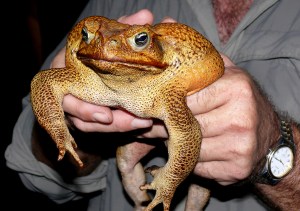Cane-toad fighting Australians had better brace themselves for more bad amphibious news this week. Researchers at the University of Sydney have found that the invasive, poisonous cane toad that has been goading the southern continent for the better part of the last century will have a distinct advantage as global temperatures continue to rise. In other words, the fat amphibians native to Central and South America are pretty much there to stay.
The researchers, who will present their work at the annual conference of the Society for Experimental Biology today in Prague, found that cane toads’ heart and lungs were actually able to get oxygen from the atmosphere more efficiently in higher temperatures, unlike fish and other cold-blooded animals which lose efficiency. Not only were the toads able to biologically perform in hotter climes, they seemed to like it there.
The study taps into an aspect of climate change that you don’t hear a whole lot about: who’s going to benefit from it. “The impact of global warming doesn’t have to be negative. Global average temperatures at present may in fact be cooler than mnay animals would like,” said Professor Frank Seebacher of the University of Sydney in a July 1 press release.
It also taps into one of the longest-running man vs. nature wars being waged on the planet. Cane toads were introduced to Australia and Hawaii in the 1930s to control beetle infestations on sugar cane. About 3000 toads were initially released on the coast of eastern Australia; there are about 90 million today. In the early years in their new continent, cane toad populations were spreading at a rate of roughly six miles 9 (10 km) a year. Today’s their ranks are taking over territory across north and western Oz at a rate closer 30 miles (50 km) per year, according to the all-things-cane-toad site canetoadsinoz.com. (Which, it should not go unnoted, has a very extensive section on cane toad sex. Just saying.)
Why is is that territorial expansion a problem? Cane toads are some of the largest toads in the world, but more importantly, they are utterly poisonous to most of the animals unfortunate enough to think they look like a big fat snack. That has included a lot of pets (read: dogs) over the years, which in turn has created cane toads’ most powerful natural enemy: the irate dead pet (read: dog) owner. The species has also been pinned with killing off other native Aussie fauna like snakes and other frogs, but how much they have actually threatened those species is a matter of some debate. The more central issue seems to be that a lot people don’t like having huge, poisonous toads hanging around their pets and kids, inspiring a kind of vigilante justice that a few researchers are trying to combat. (See this on “How to Humanely Kill a Cane Toad.”)
Love them or hate them, you’ve got to hand it to the cane toad. They can lose half their body water and survive a vast range of temperatures. They can physically adapt to a new environment, and then reverse that adaptation when the need arises. That flexibility is both the beauty and the dark force shared by other invasive species like kudzu and the infamous Asian carp, to name a few. If you live in a big city or the tropics, you know all too well that at the end of the day, when we are all long gone, cockroaches are going to be the masters of their universe. They just better hope that the cane toads can’t figure out a way to swim.



